2020 Annual Report for: Depressariidae / Depressariinae
For species seen in 2020 that had less than or equal to 100 records, full details are included; for more common species, the earliest, latest and highest count by vice-county are shown. The narrative for each species is taken from the main Hantsmoths website, and it is possible that some information on abundance and occurrence can get out of date, as it is impossible to keep up with all changes; however it should give a good introduction to each species. The tables in each species account summarise the previous status, and that for the current year.
For the maps, all records prior to 2020 are shown by a blue dot (the larger the dot, the more recent), with the current year's records shown in red. As previous records are superimposed on any report for 2020, new sites have greater emphasis (i.e. will show as 'more red').
In the species accounts, an asterisk next to a location indicates a new 10km square record; earliest ever dates are highlighted in orange, and latest ever in red. Initials in the species accounts refer to the recorders listed here. Please get in touch if you identify any omissions or errors, in particular if you have records that have yet to be submitted. Details of how to submit records can be found here.
32.001 [B&F: 0666] Semioscopis avellanella (Hübner, 1793) - Local
Local in lime woodland in the southern half of England and in mature birch woodland in Scotland and the northern half of England. There are few records of this species in Hampshire. most of which have been of single specimens, although the early flight period may lead to under-recording, and it is not a 'garden' insect. Not recorded from the Isle of Wight to date. Wingspan 20-26 mm. Similar to S. steinkellneriana, which see for differences. Larva feeds on Birch and Small-leaved Lime, living within a spun or rolled leaf, over-wintering as a pupa.
Records prior to 2020
| Vice County | #Records | #Individuals | First Record | Last Record |
|---|---|---|---|---|
| 11 | 4 | 1 | 1987 | 2005 |
| 12 | 12 | 14 | 1991 | 2014 |
2020 records
| Vice County | #Records | #Individuals | Max Quantity |
|---|---|---|---|
| 11 | 1 | 1 | 1 |

Records by year
Records by week (adult)
Records by week (larval)
Record Details
VC11: Kings Somborne, one, to actinic, 14 Mar (GCE)
32.002 [B&F: 0667] Semioscopis steinkellneriana ([Denis & Schiffermüller], 1775) - Local
Local in hedgerows and scrub, especially in blackthorn-thickets, across most of Britain, except in extreme south-west England and northern Scotland. In Hampshire and on the Isle of Wight recorded in most years, but with no discernible increase in numbers, despite the increase in observer coverage, so the decline is probably more serious than the records suggest. Wingspan 18-23 mm; S. avellanella is similar, but the wing markings are different and S. steinkellneriana lacks the obvious basal streak of S. avellanella. Males fly on sunny mornings. Larva feeds on Blackthorn, Rowan and Hawthorn, living within a spun or rolled leaf, and over-wintering as a pupa.
Records prior to 2020
| Vice County | #Records | #Individuals | First Record | Last Record |
|---|---|---|---|---|
| 10 | 3 | 2 | 1900 | 2019 |
| 11 | 70 | 98 | 1972 | 2019 |
| 12 | 36 | 40 | 1984 | 2019 |
2020 records
| Vice County | #Records | #Individuals | Max Quantity |
|---|---|---|---|
| 11 | 6 | 6 | 1 |

Records by year
Records by week (adult)
Records by week (larval)
Record Details
VC11: Romsey, one, 07 Apr; one, 10 Apr; one, 16 Apr (NRJ)
32.007 [B&F: 0701] Agonopterix ocellana (Fabricius, 1775) - Common
Common in a wide range of habitats, including woodland, hedgerows, parks, gardens and at freshwater margins, throughout the British Isles. In Hampshire and on the Isle of Wight widespread, but not particularly common, in damp places, where sallows and willows grow. Wingspan 19-23 mm. Larva feeds on White Willow, Purple Willow, Osier, Goat Willow, Grey Willow, Eared Willow and Creeping Willow, living between leaves spun together with silk.
Records prior to 2020
| Vice County | #Records | #Individuals | First Record | Last Record |
|---|---|---|---|---|
| 10 | 48 | 48 | 1893 | 2019 |
| 11 | 299 | 344 | 1971 | 2019 |
| 12 | 48 | 55 | 1988 | 2019 |
2020 records
| Vice County | #Records | #Individuals | Max Quantity |
|---|---|---|---|
| 10 | 2 | 2 | 1 |
| 11 | 9 | 9 | 2 |
| 12 | 2 | 2 | 1 |
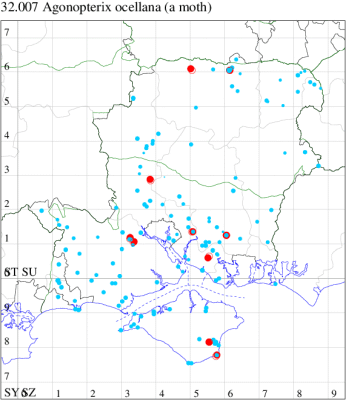
Records by year
Records by week (adult)
Records by week (larval)
Record Details
VC10: Bonchurch, one, 17 Mar (JHa); Whiteley Bank, one, at dusk, 27 Jul (IOu);
VC11: Copythorne, one, 02 Apr (JAda); Woodlands, New Forest, present, 07 Mar (RBW); Ashurst, NF, one, 19 Mar; one, 05 Apr; one, 22 Apr (SAB); Kings Somborne, two, to actinic, 21 May (GCE); Catisfield, one, to actinic, gen det, 25 Jun (ALR det. RJD); Botley, one, to actinic, 25 Jan; one, to actinic, 25 Jan (SLB); West Walk, one, field observation, 26 Oct (KJW det. RJD);
VC12: Ecchinswell, one, indoors, 12 Dec (MJN); Pamber Forest, one, field observation, 18 Dec (GJD)
32.009 [B&F: 0691] Agonopterix purpurea (Haworth, 1811) - Local
Local on downland and dry grassland throughout much of southern England and Wales, north to Lancashire. In Hampshire evidently uncommon, and absent from much of the south-west, with no recent records from the Isle of Wight. Wingspan 11-15 mm. A useful field mark is the vertical line from dorsum to upper margin of cell (MBGBI Vol 4 part 1). Larva mines leaves of Wild Carrot, Rough Chervil, Cow Parsley and Upright Hedge-parsley, subsequently living within a spun leaf.
Records prior to 2020
| Vice County | #Records | #Individuals | First Record | Last Record |
|---|---|---|---|---|
| 10 | 14 | 4 | 1856 | 2019 |
| 11 | 206 | 220 | 1990 | 2019 |
| 12 | 24 | 25 | 1987 | 2019 |
2020 records
| Vice County | #Records | #Individuals | Max Quantity |
|---|---|---|---|
| 10 | 1 | 2 | 2 |
| 11 | 3 | 3 | 1 |

Records by year
Records by week (adult)
Records by week (larval)
Record Details
VC10: Shanklin, two, 16 Aug (IOu);
VC11: Portsmouth, one, 16 Jul; one, 09 Aug; one, 10 Aug (IRT);
VC12: Cholderton, one, 08 Aug (TJN, HE); one, field observation, 11 Aug (TJN, LF)
32.015 [B&F: 0692] Agonopterix subpropinquella (Stainton, 1849) - Common
Common on waste ground, hedgerows and roadside verges throughout the British Isles. In south Hampshire, recorded in small numbers, mainly on Portsea and Hayling Islands; extremely uncommon in north Hampshire and on the Isle of Wight. Wingspan 16-22 mm. The main confusion species are A. scopariella, which always has two or three small white dots in the disc, A. propinquella, which has the costa more arched, with regular dark fuscous maculation, and apex more rounded, and A. carduella, which has a vertical dark mark near base half way to costa (MBGBI Vol 4 part 1). Larva feeds on Knapweed, Spear Thistle and Creeping Thistle, living within a spun or rolled leaf.
Records prior to 2020
| Vice County | #Records | #Individuals | First Record | Last Record |
|---|---|---|---|---|
| 10 | 17 | 6 | 1856 | 2017 |
| 11 | 115 | 127 | 1982 | 2019 |
| 12 | 17 | 17 | 1996 | 2019 |
2020 records
| Vice County | #Records | #Individuals | Max Quantity |
|---|---|---|---|
| 10 | 2 | 4 | 3 |
| 11 | 1 | 1 | 1 |
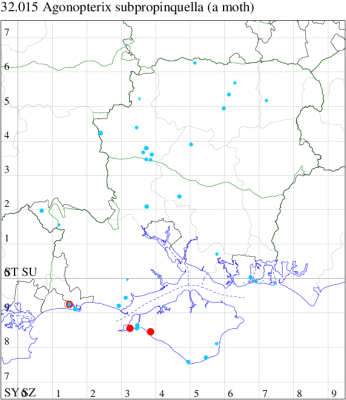
Records by year
Records by week (adult)
Records by week (larval)
Record Details
VC10: West High Down Quarry, three, 07 Aug; Brook, one, gen det, 16 Jul (IOu);
VC11: Tuckton, Bournemouth, one, 08 Aug (APar);
VC12: Cholderton, one, 31 Jul (TJN, HE); Cheriton*, one, to actinic, 16 Jul (DAS)
32.016 [B&F: 0696] Agonopterix propinquella (Treitschke, 1835) - Local
Local in waste ground and rough grassland throughout much of England, Wales, southern Scotland and southern Ireland. In Hampshire and on the Isle of Wight there have been very few recent records of this species, and it has been recorded in recent years only from Sherborne St John and Blagden Lodge, Wildhern, in the north of the county, and Shanklin on the Isle of Wight. Wingspan 16-19 mm. The most likely confusion species is A. subpropinquella, which see for differences. Larva feeds on Creeping Thistle and Spear Thistle, living within a spun or rolled leaf.
Records prior to 2020
| Vice County | #Records | #Individuals | First Record | Last Record |
|---|---|---|---|---|
| 10 | 7 | 4 | 1856 | 2002 |
| 11 | 4 | 4 | 1980 | 2018 |
| 12 | 5 | 3 | 1996 | 2015 |
2020 records
| Vice County | #Records | #Individuals | Max Quantity |
|---|---|---|---|
| 10 | 1 | 1 | 1 |

Records by year
Records by week (adult)
Records by week (larval)
Record Details
VC10: Bonchurch, one, 08 May (JHa)
32.017 [B&F: 0697] Agonopterix arenella ([Denis & Schiffermüller], 1775) - Common
Common in rough grassland, waste ground, gardens and a wide range of other habitats throughout much of the British Isles. In Hampshire and on the Isle of Wight widespread and rather common throughout. Wingspan 16-22 mm. Larva feeds on Thistle (both Carduus and Cirsium), Knapweed, Burdock and Saw-wort, living within a spun or rolled leaf.
Records prior to 2020
| Vice County | #Records | #Individuals | First Record | Last Record |
|---|---|---|---|---|
| 10 | 142 | 181 | 1856 | 2019 |
| 11 | 622 | 685 | 1971 | 2019 |
| 12 | 189 | 192 | 1975 | 2019 |
2020 records
| Vice County | #Records | #Individuals | Max Quantity |
|---|---|---|---|
| 10 | 13 | 14 | 2 |
| 11 | 28 | 31 | 4 |
| 12 | 5 | 6 | 2 |

Records by year
Records by week (adult)
Records by week (larval)
Record Details
VC10: West High Down Quarry, two, 07 Aug (IOu); Totland, one, field observation, 19 Sep (RTe); Cranmore, present, to actinic, 08 Aug (CHic); Plaish, one, 26 Sep (KRy); Haseley Manor, one, 11 Aug; one, 21 Sep; America Wood, one, 06 Apr; one, at dusk, 18 Apr; Shanklin, two, 09 Apr; one, 12 Apr; one, 15 Apr; one, 24 Jun; Sandpit Copse, one, 20 May (IOu);
VC11: Woodlands, New Forest, present, 05 Apr (RBW); Totton, one, 17 Mar (LH); Stanbrige Earls, one, to actinic, 20 Aug; one, to actinic, 26 Aug (JRMi); Timsbury, one, 22 Apr (TRa); Romsey, one, 14 May (SLay); Ashley, one, to actinic, 22 Sep; Kings Somborne, two, to actinic, 22 Sep (GCE); Romsey, one, 05 Apr; one, 19 Aug (NRJ); Ashley, one, to actinic, 22 Jul (GCE); Eastleigh, one, to actinic, 24 May (KArb); Fareham, one, 23 Apr (ADT); one, to actinic, 22 Apr (MLO); Botley, one, to actinic, 16 May; one, to actinic, 07 Jun; one, to actinic, 15 Aug; one, to actinic, 16 Aug; one, to actinic, 26 Aug; one, to actinic, 03 Sep (SLB); Portsmouth, one, 02 Aug; one, 12 Aug; one, 18 Aug; one, 07 Sep (IRT); West Meon, one, 31 Jul (F.M.G. det. RJD); Southsea, four, 10 May; one, 21 May (JGe);
VC12: Crawley, one, to actinic, 07 Sep (GCE); Basingstoke, one, field observation, 24 Jan (GSD); Pamber Forest, two, 02 Sep; one, 13 Aug (GJD); Liss Forest, one, 23 Feb (RJM)
32.018 [B&F: 0688] Agonopterix heracliana (Linnaeus, 1758) - Common
Common in gardens, waste ground, woodland edges and a wide range of other habitats throughout much of the British Isles. In Hampshire and on the Isle of Wight one of the most frequently reported depressariid moths, although not the most numerous. Wingspan 15-21 mm. Closely resembles A. ciliella, which see for differences. Dark chestnut forms can be confused with A. cnicella, but the latter has a smoother texture to the forewing and the pale basal area is suffused with white scales and never extended along the costa. A. scopariella has the forewing apex more squared and the white discal dots much smaller and usually not dark-circled. Small specimens can also be confused with A. capreolella which has a narrower forewing and darker hindwing, and A. curvipunctosa which has only one whitish dot in the disc of the forewing (MBGBI Vol 4 part 1). Larva feeds on Cow Parsley, Rough Chervil and Hogweed, living within a spun or rolled leaf.
Records prior to 2020
| Vice County | #Records | #Individuals | First Record | Last Record |
|---|---|---|---|---|
| 10 | 101 | 111 | 1884 | 2019 |
| 11 | 567 | 625 | 1971 | 2019 |
| 12 | 401 | 519 | 1974 | 2019 |
2020 records
| Vice County | #Records | #Individuals | Max Quantity |
|---|---|---|---|
| 10 | 14 | 18 | 4 |
| 11 | 17 | 17 | 1 |
| 12 | 9 | 10 | 2 |
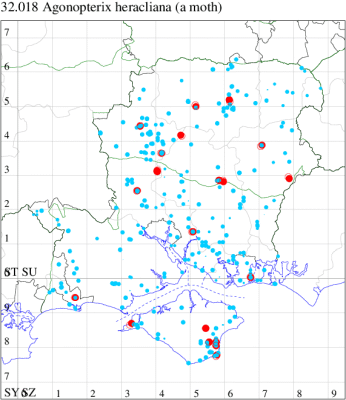
Records by year
Records by week (adult)
Records by week (larval)
Record Details
VC10: Totland, four, field observation, 19 Sep (RTe); Bonchurch, one, 26 Feb (JHa); Haseley Manor, one, 11 Aug; Shanklin, one, 11 Apr; one, at dusk, 31 Mar; one, 29 Jan; one, 08 Feb; one, to lighted window, 23 Feb; one, field observation, 04 Mar; two, 17 Mar; one, 07 Apr; one, 10 Apr; one, 30 Jul; one, 16 Aug (IOu);
VC11: Timsbury, one, to a lighted window, 08 Mar (TRa); Kings Somborne, one, to actinic, 17 Mar; one, to actinic, 17 Mar; one, to actinic, 17 Mar (GCE); Botley, one, to actinic, 25 Feb; one, to actinic, 26 Feb; one, to actinic, 19 Mar; one, to actinic, 14 Mar (SLB); Portsmouth, one, 08 Apr; one, 12 Jul; one, 15 Jul; one, 16 Jul; one, 18 Jul; one, 19 Jul; one, 23 Jul; one, 07 Aug (IRT); Burton, nr Christchurch, one, 14 Aug (JSw);
VC12: Cholderton, one, 24 Jul; one, 31 Jul (TJN, HE); Anna Valley, Andover, one, 14 Sep (TJN); Andover, one, 10 Mar (GSD); Chilbolton, one, to actinic, 14 Jul; Wonston , one, to actinic, 17 Jul (GCE); Cheriton, one, to actinic, 16 Jul (DAS); Hinton Ampner, one, indoors, 02 Dec (ASD); Overton, one, field observation, 04 May (PEH); Basingstoke, one, to actinic, 20 Jul (JHu); Liss Forest, one, to artificial light, 12 Feb (RJM); Alton, two, to artificial light, 02 Feb (DBO)
32.023 [B&F: 0716] Agonopterix rotundella (Douglas, 1846) - Nationally Scarce A
Nationally scarce (Na) on downland and coastal cliffs in England and Wales, from Cornwall to Kent, northwards along the western coast as far as Cheshire; the Isle of Man, Yorkshire and Northumberland (MBGBI Vol 4 part 1); uncommon in Wales and Scotland. Very rare on the Isle of Wight, with just 13 records prior to the present century; however, increased recording since 2010 has turned up single records in most years. Not recorded from Hampshire to date. Wingspan 14-17 mm. Larva mines leaves of Wild Carrot, subsequently living within a leaf-roll.
Records prior to 2020
| Vice County | #Records | #Individuals | First Record | Last Record |
|---|---|---|---|---|
| 10 | 17 | 8 | 1893 | 2019 |
2020 records
| Vice County | #Records | #Individuals | Max Quantity |
|---|---|---|---|
| 10 | 2 | 2 | 1 |
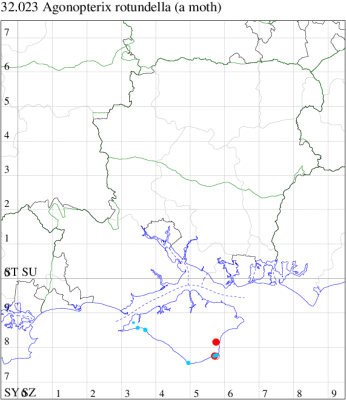
Records by year
Records by week (adult)
Records by week (larval)
Record Details
VC10: Wheelers Bay, one, 13 Apr (ABu); Shanklin, one, gen det, 04 Sep (IOu)
32.024 [B&F: 0702] Agonopterix assimilella (Treitschke, 1832) - Local
Local on heathland and in open woodland throughout much of Britain; rare in Ireland. In Hampshire widespread wherever Broom is found, but there have been no recent records from the Isle of Wight. Wingspan 15-21 mm. Most likely to be confused with A. nanatella, which see for differences; A. angelicella, which has a similarly shaped fuscous discal blotch, but it incorporates a black dot, and the forewing is usually orange-coloured; and A. kuznetzovi, in which the hindwing is dark grey, the cloudy fuscous blotch in the forewing is at one-half and never extended toward tornus, and there is a black discal dot at three-fifths which is absent in A. assimilella (MBGBI Vol 4 part 1). Larva feeds within stems of Broom, subsequently living between spun stems.
Records prior to 2020
| Vice County | #Records | #Individuals | First Record | Last Record |
|---|---|---|---|---|
| 10 | 2 | 1 | 1900 | 2010 |
| 11 | 35 | 18 | 1972 | 2018 |
| 12 | 17 | 10 | 1988 | 2017 |
2020 records
| Vice County | #Records | #Individuals | Max Quantity |
|---|
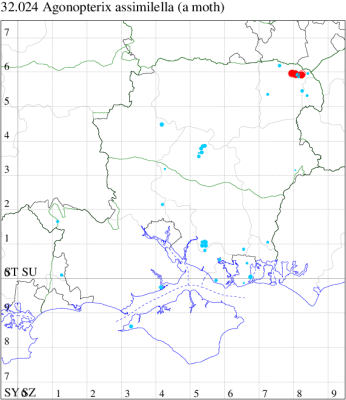
Records by year
Records by week (adult)
Records by week (larval)
Record Details
VC12: Castle Bottom NNR, one, netted, 15 Jun; Blackbushe Airfield, larva, present, field observation, abundant larval spinnings on Broom (Cysticus), 19 Nov; larva, present, field observation, numerous larval spinnings on Broom, 30 Dec; Yateley Common, larva, present, field observation, larva in silken case on Broom, 23 Nov (JHH)
32.029 [B&F: 0705] Agonopterix umbellana (Fabricius, 1794) - Local
Local on heathland and moorland throughout much of the British Isles. In Hampshire mainly confined to the heaths of the north-east and New Forest, and along the coast in the south-east. Not recorded from the Isle of Wight in recent years. Wingspan 19-24 mm. Larva feeds on Gorse and Hairy Greenweed, living within a silken tube or tent.
Records prior to 2020
| Vice County | #Records | #Individuals | First Record | Last Record |
|---|---|---|---|---|
| 10 | 13 | 5 | 1856 | 2017 |
| 11 | 31 | 53 | 1972 | 2018 |
| 12 | 8 | 10 | 1960 | 2018 |
2020 records
| Vice County | #Records | #Individuals | Max Quantity |
|---|---|---|---|
| 11 | 2 | 2 | 1 |

Records by year
Records by week (adult)
Records by week (larval)
Record Details
VC11: Dibden Purlieu, one, to actinic, 15 Aug; one, 19 Aug (RAC)
32.030 [B&F: 0706] Agonopterix nervosa (Haworth, 1811) - Common
Common on heathland and grassland, and in open woodland, throughout much of the British Isles. In Hampshire and on the Isle of Wight common wherever gorse or broom grows. Wingspan 16-22 mm. Larva feeds within young shoots of Broom, Gorse, Dyer's Greenweed and Petty Whin, beneath a silken web.
Records prior to 2020
| Vice County | #Records | #Individuals | First Record | Last Record |
|---|---|---|---|---|
| 10 | 31 | 29 | 1856 | 2017 |
| 11 | 172 | 222 | 1971 | 2019 |
| 12 | 20 | 23 | 1977 | 2018 |
2020 records
| Vice County | #Records | #Individuals | Max Quantity |
|---|---|---|---|
| 10 | 1 | 1 | 1 |
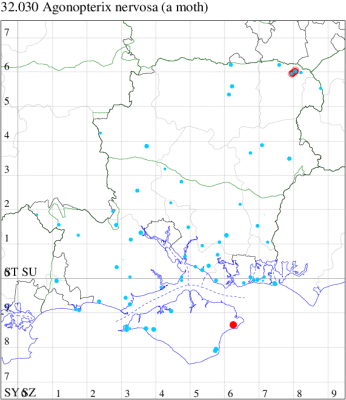
Records by year
Records by week (adult)
Records by week (larval)
Record Details
VC10: Bembridge Fort, one, 06 Aug (IOu);
VC12: Castle Bottom NNR, present, 25 Jun (JHH, AMD); Yateley, one, 17 Aug; one, 08 Sep (JHH)
32.031 [B&F: 0695] Agonopterix alstromeriana (Clerck, 1759) - Common
Common on roadside verges, waste ground, marshes and river-banks throughout the British Isles, but not in the far north. In Hampshire and on the Isle of Wight local and seldom seen in numbers, despite being one of the easiest species of this group to identify. Wingspan 17-20 mm. Fairly unmistakable combination of large black costal blotch and adjacent rusty red elongate mark, and prominent apical dots. Larva feeds on flowers and leaves of Hemlock, living within a spun or rolled leaf.
Records prior to 2020
| Vice County | #Records | #Individuals | First Record | Last Record |
|---|---|---|---|---|
| 10 | 18 | 10 | 1856 | 2019 |
| 11 | 489 | 907 | 1977 | 2019 |
| 12 | 68 | 64 | 1990 | 2019 |
2020 records
| Vice County | #Records | #Individuals | Max Quantity |
|---|---|---|---|
| 10 | 2 | 2 | 1 |
| 11 | 23 | 34 | 3 |
| 12 | 7 | 7 | 1 |

Records by year
Records by week (adult)
Records by week (larval)
Record Details
VC10: St Lawrence: Salem Close, one, to actinic, 28 Sep (PBa); Shanklin, one, 01 May (IOu);
VC11: Romsey, one, 18 Mar; one, 10 Apr (MB); Ashley, one, to actinic, 22 Sep (GCE); Portsmouth, one, 03 Apr; one, 10 Apr; two, 16 Apr; two, 14 Jul; two, 15 Jul; three, 16 Jul; two, 17 Jul; three, 18 Jul; two, 22 Jul; one, 23 Jul; one, 31 Jul; two, 05 Aug; one, 06 Aug; one, 07 Aug; one, 08 Aug; one, 09 Aug; one, 12 Aug; one, 16 Aug; two, 01 Sep; one, 20 Sep (IRT);
VC12: Over Wallop, one, 02 Apr (CM); Cholderton, one, 24 Jul; one, 08 Aug (TJN, HE); Crawley, one, to actinic, 12 Aug; Barton Stacey, one, to actinic, 16 Jul; one, to actinic, 16 Jul; one, to actinic, 16 Jul; Wonston , one, to actinic, 17 Jul (GCE); Farnborough, one, 18 Mar (KBW); Yateley*, one, 16 Apr; one, 07 Aug (JHH)
32.035 [B&F: 0714] Agonopterix yeatiana (Fabricius, 1781) - Local
Local on grassland, downland and in dry open areas in parts of the British Isles, predominantly coastal, especially in Scotland and Ireland. In Hampshire fairly widespread and locally common, but not recorded recently on the Isle of Wight. Wingspan 18-22 mm. The most likely confusion species is A. putridella, which see for differences. Larva feeds on Wild Carrot, Pepper-saxifrage, Rough Chervil, Hemlock Water-dropwort and Milk-parsley, living between leaves spun together with silk.
Records prior to 2020
| Vice County | #Records | #Individuals | First Record | Last Record |
|---|---|---|---|---|
| 10 | 34 | 27 | 1856 | 2019 |
| 11 | 406 | 498 | 1976 | 2019 |
| 12 | 47 | 76 | 1990 | 2019 |
2020 records
| Vice County | #Records | #Individuals | Max Quantity |
|---|---|---|---|
| 10 | 2 | 1 | 1 |
| 11 | 13 | 14 | 2 |

Records by year
Records by week (adult)
Records by week (larval)
Record Details
VC10: Cranmore, present, to actinic, 18 Mar (CHic); Haseley Manor, one, 28 May (IOu);
VC11: Totton, one, 05 Apr; one, 10 Apr; one, 18 Apr; one, 21 Apr (LH); Dibden Purlieu, one, to actinic, 07 Apr (RAC); Portsmouth, one, 19 May; one, 23 Jun (IRT); Tuckton, Bournemouth, one, 16 Sep (APar); Burton, nr Christchurch, two, 24 Apr (JSw); Southsea, one, 27 May (JGe); one, 20 May; one, 24 May; one, 01 Jun (JRL)
32.036 [B&F: 0672] Parsnip Moth Depressaria radiella (Goeze, 1783) - Common
Common on waste ground and dry grassland throughout much of the British Isles, more numerous on the coast. In Hampshire and on the Isle of Wight common and widespread. Wingspan 24-29 mm. separated from similar species by numerous longitudinal black streaks emanating from central area of disc, closely following venation, most terminating at fascia at three-quarters, a few passing through but always finishing before termen (MBGBI Vol 4 part 1). The imago overwinters, and may be found in man-made habitat such as thatch, stables and outhouses. Larva feeds on flowers and seeds of Wild Parsnip and Hogweed, living gregariously within spun or rolled leaves.
Records prior to 2020
| Vice County | #Records | #Individuals | First Record | Last Record |
|---|---|---|---|---|
| 10 | 138 | 245 | 1856 | 2019 |
| 11 | 241 | 331 | 1973 | 2019 |
| 12 | 118 | 180 | 1976 | 2019 |
2020 records
| Vice County | #Records | #Individuals | Max Quantity |
|---|---|---|---|
| 10 | 14 | 14 | 1 |
| 11 | 7 | 6 | 1 |
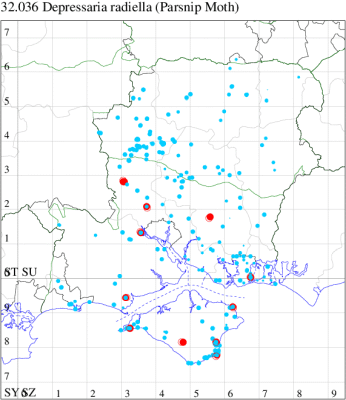
Records by year
Records by week (adult)
Records by week (larval)
Record Details
VC10: West High Down Quarry, one, 07 Aug (IOu); Kingston, one, indoors, 29 Aug (ENes); Bonchurch, one, 12 Apr; one, 23 Apr; one, 08 May; one, 21 May (JHa); Shanklin, one, indoors, 03 Apr; one, 16 Apr; one, 09 May; one, 08 Aug; one, 09 Aug; one, 13 Aug (IOu); Seaview, one, field observation, 17 Jul; one, field observation, 25 Jul (JMas);
VC11: Blashford Lakes*, present, field observation, 18 Aug (DAS); Totton, one, 21 May (LH); East Tytherley, one, to actinic, 10 Aug; one, to actinic, 10 Aug (GCE); Romsey, one, 02 Apr (MB); Bishop's Waltham, larva, present, field observation, 03 Jul (DTr); Portsmouth, one, 09 May (IRT); Pennington, one, 15 Mar (RFC)
32.039 [B&F: 0670] Depressaria daucella ([Denis & Schiffermüller], 1775) - Common
Common in ditches, marshes, river-banks, water meadows and damp moorland throughout much of Britain, more numerous in the west, and apparently absent from northern Scotland, Orkney, and Shetland; also recorded from several Irish sites. In Hampshire common and widespread in marshes and ditches where the foodplant, mainly Hemlock Water-dropwort, occurs; very local on the coast of the Isle of Wight. Wingspan 22-25 mm. Resembles D. ultimella, which has a smaller wingspan and disc of the forewing conspicuously cream; in D. daucella the disc is buff and inconspicuous. Like many Depressaria, it overwinters, and is often recorded hibernating in thatch. Larva mines flowering stems of various species of Water-dropwort, subsequently feeding on the flowers and seed heads.
Records prior to 2020
| Vice County | #Records | #Individuals | First Record | Last Record |
|---|---|---|---|---|
| 10 | 76 | 327 | 1893 | 2019 |
| 11 | 362 | 1356 | 1974 | 2019 |
| 12 | 48 | 63 | 1981 | 2019 |
2020 records
| Vice County | #Records | #Individuals | Max Quantity |
|---|---|---|---|
| 10 | 6 | 5 | 1 |
| 11 | 10 | 12 | 3 |

Records by year
Records by week (adult)
Records by week (larval)
Record Details
VC10: Plaish, one, field observation, 25 Sep (KRy); Newtown, larva, one, field observation, on Hemlock Water-dropwort, 17 May; Newtown Meadows, larva, present, field observation, lots of larvae on Hemlock Water-dropwort, 17 May (IOu); Bonchurch, one, 10 Apr (JHa); Rookley, one, to actinic, 01 Apr (JBa); Shanklin, one, 05 Apr (IOu);
VC11: Woodlands, New Forest, present, 18 Mar (RBW); Totton, two, 17 Mar; one, 10 Apr (LH); Wildern LNR, larva, one, field observation, on Hemlock Water-dropwort , 27 May (TCr); Lower Titchfield Haven NNR, larva, present, field observation, larvae feeding on flower heads of Oencrocata, 28 May (MHak); Portsdown, larval spinning, three, on host-plant, spinnings on Pastinaca sativa, 20 Jul (RJD); Tuckton, Bournemouth, one, to actinic, 18 Mar; one, 09 Apr; one, 10 Apr; two, 17 Aug (APar)
32.040 [B&F: 0671] Depressaria ultimella Stainton, 1849 - Local
Local in ditches, marshes and water meadows, and on river-banks in southern England from Kent to Cornwall, through central England as far north as Lancashire and north-east Yorkshire; also in Wales and southern Ireland. In Hampshire there are a few scattered records in both the north and south, and first recorded on the Isle of Wight at Freshwater in 2010. Wingspan 16-21 mm. Resembles D. daucella, which see for differences. Larva feeds on stems and leaves of Fool's Water-cress, Greater Water-parsnip, Hemlock Water-dropwort and Fine-leaved Water-dropwort, overwintering as an adult.
Records prior to 2020
| Vice County | #Records | #Individuals | First Record | Last Record |
|---|---|---|---|---|
| 10 | 1 | 1 | 2010 | 2010 |
| 11 | 12 | 13 | 1982 | 2014 |
| 12 | 11 | 13 | 1996 | 2019 |
2020 records
| Vice County | #Records | #Individuals | Max Quantity |
|---|---|---|---|
| 10 | 1 | 2 | 2 |

Records by year
Records by week (adult)
Records by week (larval)
Record Details
VC10: Shanklin*, two, gen det, 09 May (IOu)
32.044 [B&F: 0677] Depressaria douglasella Stainton, 1849 - Nationally Scarce B
Nationally scarce (Nb) in grassland and waste ground throughout much of England. In Hampshire and on the Isle of Wight recorded from a handful of sites, and quite rare in North Hampshire. Wingspan 17-21 mm. The main confusion species are D. pulcherrimella, in which the angle made by the pale fascia on the forewing forms a right-angle (obtusely angled in A, douglasella), and D. sordidatella, which differs in the slightly glossy, less heavily marked forewing and the darker head, thorax and tegulae (MBGBI Vol 4 part 1). Larva feeds on Wild Carrot, Wild Parsnip and Upright Hedge-parsley, living between leaves spun together with silk.
Records prior to 2020
| Vice County | #Records | #Individuals | First Record | Last Record |
|---|---|---|---|---|
| 10 | 5 | 2 | 1893 | 1984 |
| 11 | 13 | 11 | 1975 | 2004 |
| 12 | 4 | 3 | 1979 | 2015 |
2020 records
| Vice County | #Records | #Individuals | Max Quantity |
|---|---|---|---|
| 12 | 1 | 1 | 1 |

Records by year
Records by week (adult)
Records by week (larval)
Record Details
VC12: Barton Stacey*, one, to actinic, 14 Aug (GCE)
32.050 [B&F: 0646] Telechrysis tripuncta (Haworth, 1828) - Nationally Scarce B
Nationally scarce (Nb) in woodland and hedgerows in parts of England, except the north-east, and in north Wales. A scarcely seen insect in Hampshire with a very scattered distribution, mainly away from the chalk; there are two old records from the Isle of Wight. Wingspan 11-14 mm. The three pale, evenly-spaced spots on each forewing make this a distinctive member of the Oecophoridae. Larva feeds on dead wood, perhaps most frequently of Hazel.
Records prior to 2020
| Vice County | #Records | #Individuals | First Record | Last Record |
|---|---|---|---|---|
| 10 | 22 | 26 | 1900 | 2019 |
| 11 | 23 | 23 | 1973 | 2012 |
| 12 | 7 | 14 | 1992 | 2013 |
2020 records
| Vice County | #Records | #Individuals | Max Quantity |
|---|---|---|---|
| 10 | 5 | 5 | 1 |

Records by year
Records by week (adult)
Records by week (larval)
Record Details
VC10: Bonchurch, one, 30 May; one, 11 Jun; one, 19 Jun (JHa); Shanklin, one, 12 Jun; one, 24 Jun (IOu)